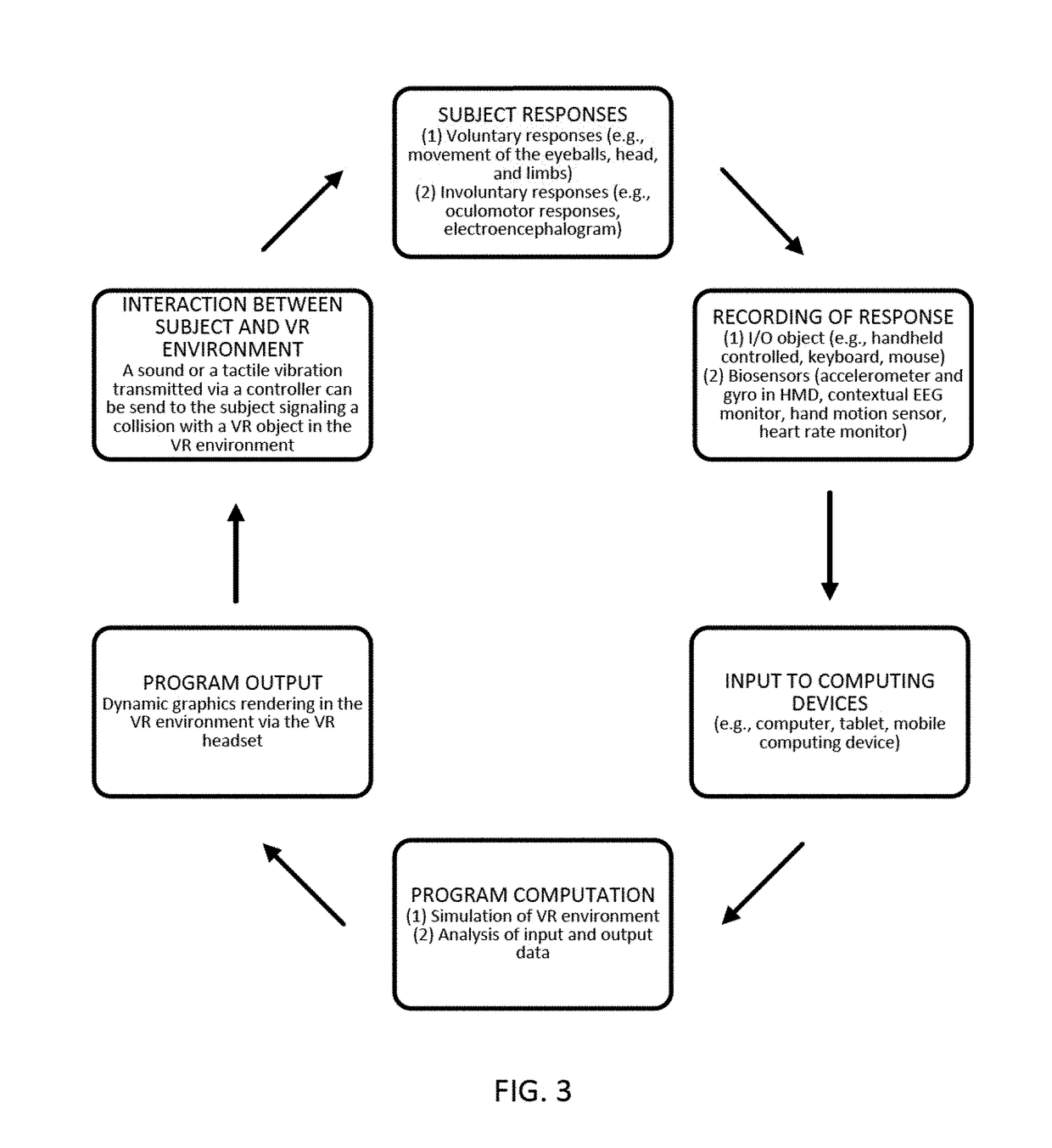Visual disability detection system using virtual reality
a visual disability and detection system technology, applied in the field of visual disability detection system using virtual reality, can solve the problems of difficulty in assessing the impact of visual performance on the activities of daily living in clinical medicine, inability to routinely test functional indicators, and inability to see clearly and other visual performance indicators, so as to achieve better clinical management
- Summary
- Abstract
- Description
- Claims
- Application Information
AI Technical Summary
Benefits of technology
Problems solved by technology
Method used
Image
Examples
example 1
Navigation in a Busy City Area
[0036]In some embodiments, a busy city area in which stationary (e.g. street light pole, trash bin) and dynamic (e.g. pedestrians, vehicles) objects are simulated. The subject is asked to navigate from location A to location B without bumping into any objects or persons in the VR environment. Head and / or body motion data are measured and monitored in real-time during VR simulation with motion sensors in the HMD. The subject navigates in the VR environment by changing head and / or body orientation and the navigation speed can be adjusted with a controller in hand or a motion detector of the lower limbs. The subject directly interacts with the VR environment and the VR graphics change in response to the subject's responses. The program can generate an alert in the form of visual and / or audio cues to the subject when a collision with the VR objects occurs. The program detects and measures the number of collisions, the angle and the speed of collision betwee...
example 2
Walking Up or Down Flights of Stairs
[0038]In some embodiments, the subject is asked to walk up and down several flights of stairs without bumping into obstacles or people along the path. Head and / or body motion data are measured and monitored in real-time during VR simulation with motion sensors in the HMD. The subject navigates in the VR environment by changing head and / or body orientation and the navigation speed can be adjusted with a controller or a motion detector of the lower limbs. The subject directly interacts with the VR environment and the VR graphics change in response to the subject's responses. The program can generate an alert in the form of visual and / or audio cues to the subject when a collision with the VR objects occurs. The program detects and measures the number of collisions, the angle and the speed of collision between the subject and VR objects, the moving direction (upward, forward or downward) of the subject in the VR environment, the size, color and / or con...
example 3
Driving
[0039]In some embodiments, the program provides a driving simulation including stationary (e.g. roadblocks, lampposts, trees, cars on the road side, etc.) and dynamic (e.g. vehicles, pedestrians crossing the road, highway maintenance workers, stray and wandering animals, etc.) objects in the VR environment. The VR environment can be simulated in different traffic and weather conditions (e.g. highway, city traffic, uphill, downhill, heavy rain, etc.). The subject is required to drive from location A to location B without colliding with any objects in the VR environment. Head and / or body motion data are measured and monitored in real-time during VR simulation with motion sensors in the HMD. The subject can turn a wheel controller to change the direction of navigation and the navigation speed can be changed with an accelerator and a brake controller. The subject directly interacts with the VR environment and the VR graphics change in response to the subject's responses. The prog...
PUM
 Login to View More
Login to View More Abstract
Description
Claims
Application Information
 Login to View More
Login to View More - R&D
- Intellectual Property
- Life Sciences
- Materials
- Tech Scout
- Unparalleled Data Quality
- Higher Quality Content
- 60% Fewer Hallucinations
Browse by: Latest US Patents, China's latest patents, Technical Efficacy Thesaurus, Application Domain, Technology Topic, Popular Technical Reports.
© 2025 PatSnap. All rights reserved.Legal|Privacy policy|Modern Slavery Act Transparency Statement|Sitemap|About US| Contact US: help@patsnap.com



